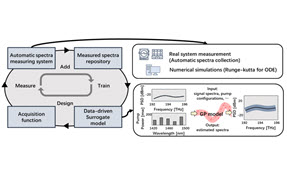Detecting chemical, biological, and explosive agents
The detection and measurement of chemical, biological, and explosive agents is becoming more important and receiving much greater emphasis within the optics, military, and international communities. The choice of detection technique depends on the agent being sought, expected background interferences, and whether point samples or stand-off ranges are required.
Many current and developing techniques employ optical and laser spectroscopic sensing, or include conventional analytical chemistry systems based on mass spectrometry or gas chromatography. Optics generally plays the role of ‘enabling technology’ in these systems, as defined in the 1998 National Research Council report, Harnessing Light: Optical Science and Engineering for the 21st Century.
For example, optical spectroscopy is familiar as a tool for chemical species identification based on absorption, Raman, or fluorescence spectra. However, many are not aware of its widespread use in commercial medical tests, such as blood analysis, to analyze specimens. In the following, I expand on this theme, and present an overview of some emerging technologies and research challenges in the detection of chemical, biological, and explosive agents.1–7
The standoff, or remote, detection of chemical agents—such as VX, mustard gas, and GA nerve agents—has been studied for over 30 years. These efforts probably started in the late 1970s with the early programs out of the US Army Edgewood/Aberdeen group (now Edgewood Chemical and Biological Center, ECBC).
Many chemical agents have unique absorption spectra in the 9-to-11μm wavelength range, and sufficient absorption cross sections for detection at trace concentration levels. Early work centered around using a Fourier-transform IR (FT-IR) spectrometer to detect agent clouds from several kilometers away, and using a rapidly tuned CO2 laser differential absorption lidar (DIAL) for the active remote sensing of a chemical agent.
The current system, a frequency-agile lidar (FAL), scans up to 80 different laser lines at a rate of about 150 different lines per second, which allows the rapid measurement of a complete spectral signature. The FT-IR sensor is now used in the Army M21 Joint Service Lightweight Standoff Chemical Agent Detector (JSLSCAD), a stand-off sensor that has good-to-moderate sensitivity, but is limited to background scenes without high IR emission. While the DIAL system can overcome such background interference effects, the cost is increased weight and size.
Recently, several commercial IR hyperspectral imaging systems have been developed that not only detect unique chemical agent spectra, but can also image the scene. For example, Figure 1 shows the real-time identification and imaging of chemical cloud releases of ammonia and SF6 made possible using Telops Corp.';s Fourier-transform infrared spectral technology (FIRST) instrument. As can be seen, the hyperspectral imaging capability enhances the detectability of a release. Further work is being conducted by ECBC/Edgewood to improve the image size, sensitivity, and background rejection.

There are several detection techniques used for the close-in, or point-sampling, detection of chemical agents. Most of these involve the use of a compact mass spectrometer, gas chromatography, ‘lab-on-a-chip’, or very sensitive optical absorption techniques. The Department of Defense Improved Chemical Agent Monitor (ICAM) developed by General Dynamics uses an ion mobility spectrometer to detect trace chemical agents.
Other, more sensitive techniques include laser-cavity ring-down detection that provides parts-per-trillion trace-gas detection (Picarro, Inc.); ultra-sensitive photoacoustic spectroscopy (DARPA and Pranalytica, Inc.); and real-time water monitoring using laser-induced fluorescence (ECBC, US Army Research Office, Defense Threat Reduction Agency or DTRA, and our team). Work is underway to extend these techniques to wavelengths of 3μm and longer.
Chemical detection systems involving species-specific polymer-based absorption by wafer-sized films are very sensitive for a particular species, but have some shortcomings. Work is being conducted to improve their false-alarm rates in the presence of a high background of interfering species, and to improve repeatability, which can be degraded by hysteresis effects.
Also employed at close range are Raman lidar and laser-induced-breakdown spectroscopy (LIBS). Raman lidar can help identify chemical species in samples such as white powders and liquid in containers, and LIBS is being developed for trace-element detection at close-to-moderate ranges. These techniques also have utility in bio-agent and explosives detection.
Biological agent detection has, until recently, employed techniques used by the medical and biological communities. Most current bio-agent sensing approaches require point detection or point sample extraction, followed by biological discriminant detection. These discriminants include size and shape analysis (e.g. anthrax rod shape), mass spectrometry, DNA/RNA structure sequencing, cell membrane composition, and optical properties.
DNA detection involves the polymerase chain-reaction amplification of DNA strands, and a careful 6-to-24 hour procedure to chemically subtract and isolate background interferences. A DNA sequencer then uses selected dyes and laser fluorescence to automatically read the information.
The RAPTOR system, developed out of the Naval Research Laboratory, uses fluorescence-tagged antigens to detect anthrax and several other bio-agents, while a new technique developed by Hollis (MIT Lincoln Lab) uses fluorescing B-cells without the need for a tagged antigen. Many recent advances in this field involve the parallel processing of large arrays of samples to decrease detection time.
Some new optical spectroscopic techniques are being developed to allow the real-time biological detection without the need for reagents. For example, optical imaging is being combined with UV-excitation fluorescence imaging and hyperspectral Raman imaging to detect and identify organisms in the presence of complex background interference. Figure 2 shows the dual Raman and fluorescence detections of Bacillus globigii (BG) spores against a background of other dust particles and related humic acid and bio-organisms using the FALCON chemical imaging microscope system (ChemImage Corp.).

Figure 2 illustrates a chemical imaging strategy that uses chemometric statistical analysis to improve its reliability, and fuses multiple independent optical detection methods. This ‘sensor fusion’ approach greatly enhances the overall sensitivity, and has been used for years in the medical community where multiple tests are often requested for diagnostic confirmation. Receiver operating characteristic (ROC) curves are used to assess these situations by showing the tradeoff between false alarm rate and detection probability or S/N ratio. In fact, all chemical, biological and explosive agent detection techniques, including those described here, are now being evaluated using ROC curves.
Another bio-agent detection system, the biological agent warning sensor (BAWS) system, detects bio-aerosols contained in air-sampler flows using the fluorescence and scattering of UV laser light. Such a system serves as an early warning system, but must be followed by confirmation using standard bio-detection techniques.
The remote detection of biological agents is much harder to accomplish than it is for chemical agents. Fluorescence lidar has been used for this purpose, but has limited discrimination: bee pollen appears similar to BG spores, for example. Some promise has been seen in recent work investigating multi-wavelength UV lidar. MIT Lincoln Laboratory is developing a mid-IR polarization lidar that shows significant potential for the stand-off discrimination between bio-agent aerosols and natural organic particles. Also, ECBC has found promising initial results in using a 10μm DIAL-based frequency-agile lidar system for stand-off detection of selected bio-agents.
An exciting new area of research is the use of terahertz (THz) waves for the short-range remote detection of bio-species and explosives, which can both show distinct spectral features. The advantage of THz wavelengths (30 to 600μm) is that they can penetrate several centimeters of clothes and packing materials. Significant work is being conducted to ascertain the THz spectroscopy of background interferences, and to develop better THz laser sources and detectors.
Only a few classes of explosives have sufficient vapor pressure to permit detection of gas clouds from afar. Instead, most are detected from trace samples obtained by swabbing the suspected area, followed by mass-spectrographic or gas-chromatographic detection.
The stand-off detection of explosives is being pursued by several agencies and laboratories. Some of the more promising techniques include work by Sharma on the remote Raman lidar detection of RDX explosive samples, remote LIBS detection of TNT solid samples by the Army Research Lab (Miziolek), DIAL sensing of selected explosive vapors by our group, and coherent CARS detection of remote samples.
In some of these cases, new types of lasers (such as room temperature tunable quantum cascade lasers and mid-IR pulsed lasers) will greatly enhance the detection capability. Most of these techniques are being developed as part of a larger combined effort using sensor fusion.
Other research is being pursued to detect chemicals related to the manufacturing of the explosive. Also, millimeter radar imaging can, in some cases, detect hidden packages under clothes when coupled with video tracking, but further testing is required to determine the overall false alarm rate and utility.
Several challenges face the future development and possible commercialization of the techniques described here for detecting bio-, chemical, and explosive agents. Five of these drive the major efforts in sensor research and development by agencies such as DARPA, DTRA, and the Department of Homeland Security.
One challenge is the need for better optical spectroscopy measurements to bridge gaps in our knowledge, such as those concerning deep-UV excitation, excitation-emission-matrix (EEM) spectra, resonance Raman EEM, THz spectra, and polarization EEM. Another is the need for continual system field-testing to determine the effectiveness of the sensors against different interfering backgrounds.
Two further challenges are the lack of high-power, room-temperature tunable lasers in the deep-UV and mid-IR ranges, and the lack of materials that mimic the optical response of bio-agents. More commonly, available medical-type simulants are used to mimic the biomedical human-organism response.
Finally, there is a need for customized fluorescence agents at the wavelengths to be used in the newer approaches, such as those generated by tunable and deep-UV lasers. Previously, most agents were developed for blue/green argon ion laser excitation.
Prof. Dennis Killinger has over 30 years experience in optics, atmospheric lidar, and laser remote-sensing research. He was a program manager for laser remote sensing at MIT Lincoln Laboratory, and is currently a Distinguished University Professor in the Department of Physics at the University of South Florida. Dr. Killinger has authored over 200 papers and research reports, and holds several research patents on laser spectroscopic applications. In addition, he is actively involved in the use of optics and photonics for homeland security, has given short courses for SPIE on Optical-Electronics for Homeland Security, and has recently given an archived one-hour webcast course for Laser Focus World on the subject.



